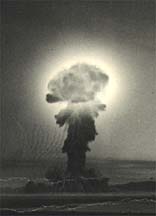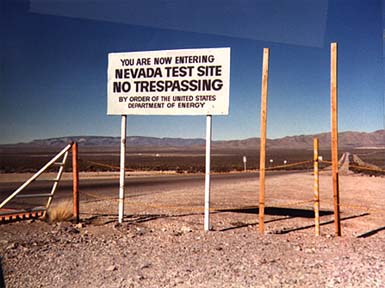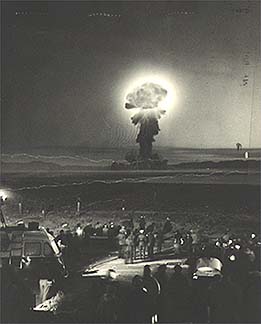MORE NUCLEAR NAILS
Lawrence Charles Jorgensen
Professor of History and Political Science -- May, 1984

For starters, some exciting or depressing facts:
"The unleashed power of the atom has changed everything except our ways of thinking. We shall require a substantially new manner of thinking if mankind is to survive." -- Albert Einstein.
A single one-megaton nuclear warhead can unleash the blast damage that decapitated Mount St. Helens, in the state of Washington. A one-megaton bomb, or "nuclear device," has 50 times the explosive power of the United States' bomb dropped on Hiroshima.
A single Soviet Union's intercontinental SS-18 has a throw-weight approaching 25 megatons, which means it has about 25 times the destructive power of the Mount St. Helen's blast, as well as being about (5O x 25)1,250 times as powerful as the Hiroshima bomb (plus or minus, of course); 80 civilian nuclear reactors are in operation today throughout the United States, each of which has varying amounts of highly radioactive wastes stored onsite;
More than 20 million Americans live within 30 miles of a nuclear power plant; some ten million reside within a mere 20 miles.
While billions of dollars have been spent in the effort to "harden" defense installations against nuclear attack, nothing has been done to protect nuclear power plants or the highly radioactive storage facilities holding the nation's high level radioactive wastes, most of which are, of course, stored next or near to the nuclear reactors that generated the waste.

Nevada Test Site, 1980's
"For more than thirty years civilian nuclear power reactors have posed a clear and present danger to national security." The United States government, however, has been silent on the danger. The American public has been kept unaware of the peril. But, then on June 7, 1981, an Israeli jet raid on the outskirts of Baghdad 'blew the lid off Pandora's box. The secret was out. Nuclear reactors are strategic targets...In an age of nuclear war, nuclear weapons and nuclear reactors can no longer exist." Gar Smith, "Nuclear Reactors and Nuclear War," Not Man Apart, June, 1983, pp. 20-21 (I urge everyone to read Gar Smith's complete article, to which my essay is especially indebted.).
In 1979, the United States government’s Congressional Office of Technology Assessment, in a study entitled The Effects of Nuclear War, warned that "the most vulnerable element of the US economy was judged to be the energy supply system."
Now, some editorializing:
That energy supply system, without which neither the United States nor the American people could survive, consists mainly of the following components: Over 300 oil refineries throughout the nation, the hundreds of miles of oil pipe lines and their required pumping plants; the natural gas fields, with their hundreds of miles of pipe lines and their required pumping plants; the hundreds of large hydroelectric dams and their thousands of miles of transmission lines ... in sum, it was the entire national energy infrastructure that was judged to be most vulnerable. However, even that report neglected to mention nuclear power reactors, which are already producing 300 billion kilowatt hours of electricity yearly.
Perhaps some enemy of the United States, the Soviet Union for example, will target only the military installations, a few of the oil fields and refineries, the natural gas fields and a few of the larger hydroelectric dams. Perhaps that enemy, the Soviet Union for example, would deliberately and accurately avoid striking any of the 80 large operating nuclear power complexes, including the various storage facilities for the high level radioactive wastes, such as those 21 million gallons stored at Savannah River, 60 miles upwind of Charleston, South Carolina. Sure!

Yucca Flats, Nevada. 1953
Ah, but what if a single one-megaton bomb (missiled or truck delivered) was exploded near the containment vessel of a nuclear power reactor and its nearby waste storage facility? How's that for a grim scenario?
Two Massachusetts Institute of Technology scientists, Kosta Tsipis and Steve Fetter, "have investigated just such an eventuality." Their study, entitled 'Catastrophic Radiation Releases,' was discussed in the April, 1981, issue of Scientific American. The complete study was obtained by the Friends of the Earth and discussed in that organization's magazine, Not Man Apart, for June, 1983.
The following is based upon the unhappy assumption that a single one megaton bomb (not a 10, 15, or 25) was exploded at a typical nuclear power plant (a one-gigawatt nuclear reactor).
"The lethal zone for the detonation of the weapon on the reactor would be more than 500 square miles, an area 30% larger than the lethal zone created by the detonation of the weapon alone," Tsipis and Fetter estimated. Also a fireball rising 12 miles into the sky would carve a crater 400 feet deep and spread a lethal blanket of molten rock and white ash over 4,500 square miles. Furthermore, a 30% increase in delayed casualties can be expected; anyone who could not swiftly relocate would probably be dead within two months.
While the area lethally contaminated would not be significantly larger, solely because the weapon was detonated on a reactor, "the length of time a given area is made uninhabitable ... is significantly larger ... ten times larger in the case of the reactor-bomb combination." This is because a bomb generally yields short-lived radioactive fallout, while a blasted reactor would scatter long-lived isotopes over the land. The total loss, according to Tsipis and Fetter, would be "of the order of 4,000 square-mile-years; consequently it would result in vast capital losses that would dwarf losses from any other single natural disaster in the history of the modern world." The MIT scientists added that hundreds of square miles would remain 'inaccessible for over a hundred years, creating a permanent monument to the event. It is doubtful that decontamination procedures could mitigate these losses, even if decontamination proved cost-effective." Right, and who is going to be around, willing to pay for "a permanent monument to the event"?
All this, remember, from one bomb on one reactor, a one-megaton bomb.
If that single one-megaton bomb was exploded directly above those tanks holding the 21 million gallons of high level radio-active waste at Savannah, South Carolina (remember that there are other storage tanks elsewhere in the country), Tsipis and Fetter predict that the tanks "and their contents would be instantaneously vaporized, and their radioactive contents would rise with the fireball and join the weapon debris," to form the deadliest fallout imaginable. It would extinguish all life in an area the size of Utah (85,000 square miles). And even after 100 years, an area the size of Rhode Island would still be poisoned with radioactivity.
All the legacy of a single one-megaton bomb!
"Each new reactor placed in operation," therefore, according to Gar Smith, "becomes a new target--with a 40-to-1 payoff in death for any incoming missile that triggers it.... the reactors endanger national defense."
So, what is going on? To whom are we paying our taxes, and sometimes our lives, to protect us ... and from whom? Just exactly who is the bloody enemy ... the ones trying to kill us?
Perhaps the Soviet Union is behind the nuclear power industry in the United States? No, because they have built nuclear power plants all over the USSR themselves. Perhaps Edward Teller and the world-wide fraternity of nuclear power advocates are really a secret international organization of nihilists, bent on the destruction of the planet's ability to support human existence? No, they probably do not even know the meaning of the word 'nihilist,' much less the philosophy underlying it.
Actually, Edward Teller (the "father of the hydrogen bomb") always argued that nuclear reactors could never be built nor operated in a fool-proof manner. Many years ago, Teller called for the construction of nuclear power reactors to be underground, in order to minimize the effects of a catastrophic reactor mishap, accidental or deliberate -- deliberate as in either war or sabotage.
So, if the nuclear power industry's leading scientist apparently knew years ago about the dangers of surface-built nuclear reactors, why weren't they built underground? That's a good question. Probably, you already know the answer. MONEY. So, What else is new?
As Gar Smith points out, a 1974 issue of Nuclear, a nuclear power industry magazine, argued that an additional 21 million dollars would have to be added to the cost of reactor construction in order to excavate the 770,000 cubic yards of earth necessary to bury the Indian Point 3 reactor. That meant, in addition to adding over 10% to the cost of construction, an additional two-and-one-half years of work would be required, which meant an additional two-and-one-half years before they could start charging and collecting. And that was bad business, as viewed from the "bottom line."
Probably everyone now knows that the nuclear power industry is a financial disaster. Had the highly vaunted forces of the 'free market" been allowed to operate years ago, if those forces were allowed to operate even now, there would be no nuclear power industry in the United States; there would be no danger of Three Mile Island meltdowns; and there would be no targets just sitting there inviting attack by a foreign enemy, a domestic-type terrorist, or by someone who is simply very, very angry and, therefore, a "nut.'
Taxpayers and the users of electricity-usually the same people, paying twice for the same product -- subsidize this monstrous and very expensive technological toy for men who, I should think, have much more important things to do with their lives. What, do you suppose, they tell their children and grandchildren when asked, "And what do you do for a living?"
But, though they be greedy and immoral, what are we who allow them to mortgage and hostage us? Stupid ... Impotent?
"We are now faced with the fact that tomorrow's today. Over the bleached bones and jumbled residues of numerous civilizations are written the pathetic words: 'Too Late.' There is an invisible book of life that faithfully records our vigilance or our neglect, chaos or community." -- Martin Luther King, Jr. 1967.
Well, we never listened to Einstein, so what are the chances of us listening to King?
Comments | LCJs Home Page | LCJ Valley Collage | to the top